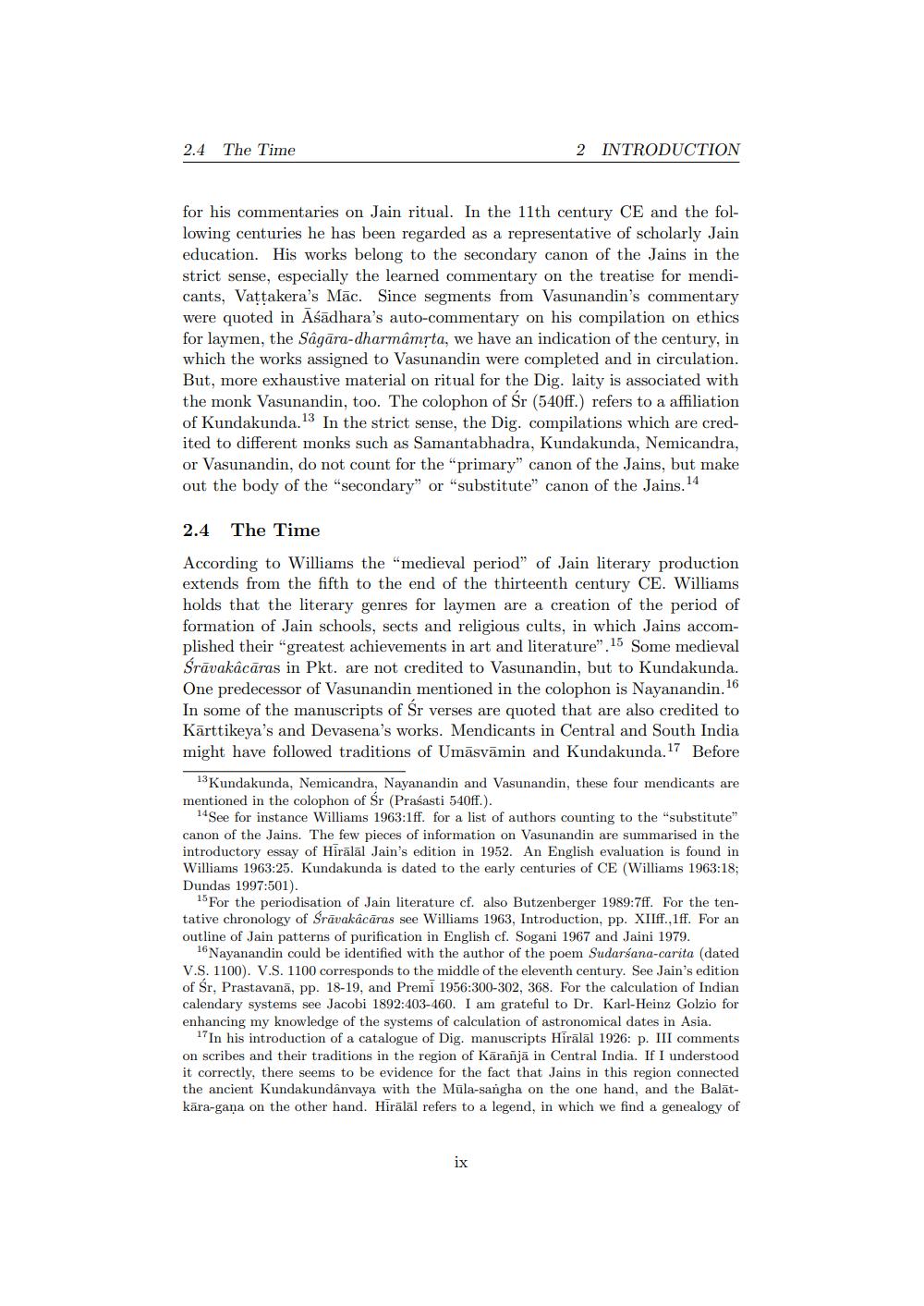________________
2.4
The Time
2 INTRODUCTION
strict sense, especially the learned.com
for his commentaries on Jain ritual. In the 11th century CE and the following centuries he has been regarded as a representative of scholarly Jain education. His works belong to the secondary canon of the Jains in the strict sense, especially the learned commentary on the treatise for mendicants, Vattakera's Māc. Since segments from Vasunandin's commentary were quoted in Asadhara's auto-commentary on his compilation on ethics for laymen, the Sagara-dharmâmrta, we have an indication of the century, in which the works assigned to Vasunandin were completed and in circulation. But, more exhaustive material on ritual for the Dig. laity is associated with the monk Vasunandin, too. The colophon of Sr (540ff.) refers to a affiliation of Kundakunda. 13 In the strict sense, the Dig. compilations which are credited to different monks such as Samantabhadra, Kundakunda, Nemicandra, or Vasunandin, do not count for the "primary" canon of the Jains, but make out the body of the "secondary" or "substitute” canon of the Jains.14
2.4 The Time According to Williams the "medieval period" of Jain literary production extends from the fifth to the end of the thirteenth century CE. Williams holds that the literary genres for laymen are a creation of the period of formation of Jain schools, sects and religious cults, in which Jains accomplished their greatest achievements in art and literature". 15 Some medieval Srāvakâcāras in Pkt. are not credited to Vasunandin, but to Kundakunda. One predecessor of Vasunandin mentioned in the colophon is Nayanandin. 16 In some of the manuscripts of Sr verses are quoted that are also credited to Kārttikeya's and Devasena's works. Mendicants in Central and South India might have followed traditions of Umāsvāmin and Kundakunda. 17 Before
13 Kundakunda, Nemicandra, Nayanandin and Vasunandin, these four mendicants are mentioned in the colophon of Sr (Prasasti 540ff.).
14 See for instance Williams 1963:1ff. for a list of authors counting to the "substitute" canon of the Jains. The few pieces of information on Vasunandin are summarised in the introductory essay of Hirālāl Jain's edition in 1952. An English evaluation is found in Williams 1963:25. Kundakunda is dated to the early centuries of CE (Williams 1963:18; Dundas 1997:501).
15 For the periodisation of Jain literature cf. also Butzenberger 1989:7ff. For the tentative chronology of Srāvakácāras see Williams 1963, Introduction, pp. XIIff.,1ff. For an outline of Jain patterns of purification in English cf. Sogani 1967 and Jaini 1979.
16 Nayanandin could be identified with the author of the poem Sudarsana-carita (dated V.S. 1100). V.S. 1100 corresponds to the middle of the eleventh century. See Jain's edition of Sr. Prastavanā, pp. 18-19, and Premi 1956:300-302, 368. For the calculation of Indian calendary systems see Jacobi 1892:403-460. I am grateful to Dr. Karl-Heinz Golzio for enhancing my knowledge of the systems of calculation of astronomical dates in Asia.
In his introduction of a catalogue of Dig. manuscripts Hirālāl 1926: p. III comments on scribes and their traditions in the region of Kārañjā in Central India. If I understood it correctly, there seems to be evidence for the fact that Jains in this region connected the ancient Kundakundânvaya with the Mūla-sangha on the one hand, and the Balātkära-gana on the other hand. Hiralal refers to a legend, in which we find a genealogy of




